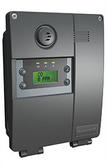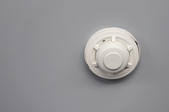Carbon Monoxide and Gas Detection
Best Defense Offers Gas Detection Systems - Keep Your Properties Safe For Less Money
Carbon monoxide and other dangerous gases (nitrogen dioxide, hydrogen, methane etc.) are a hazard for enclosed structures such as parking garages, loading docks, maintenance garages, boiler rooms, indoor stadiums and more. Running vehicles, fork lifts, utility facilities, furnaces, and sewers emit breathable hazards that often are odorless and/or colorless and can lead to explosions and death from oxygen deficiency.

Aspirating Smoke
Detection
Best Defense Offers Aspirating
Smoke Detectors.

Alarm System
Alarm system sirens emit a
loud sound when triggered,
scaring away intruders and
alerting others of an intrusion.

Open Area Smoke
Detection
Smoke Detection for Buildings
with Large Open Space

A constant or timed air exchange can keep quantities of these dangerous gases from building, for a large power cost. For example, a 10 amp fan running continuously due to faulty or no monitoring can result in an electrical cost of $2300 in just one year. The exhaust fans used in these areas are large, powerful, and capable of moving tens of thousands of cubic feet of air per minute. Not only do you pay for the power to run the fan, but in a heated or air-conditioned space, you’re also paying for all the warm / cold air you just vented into the outdoors.
Honeywell E3Point Gas Monitor
In another example of an unmonitored system, air intake screens on an underground parking garage were plugged with leave and plant debris. This prevented the ventilation fan, despite its power, from drawing fresh air into the garage. The resulting low pressure actually pulled air instead from the building’s mechanical room, including through the exhaust vents of the large water heaters. The carbon monoxide those vents were supposed to be expelling was instead getting pulled into the parking garage.
All enclosed parking garages in North America are subject to ventilation standards established by the International Mechanical Code (IMC) and the American Society of Heating, Refrigeration, and Air-Conditioning Engineers (ASHRAE). The IMC and ASHRAE stipulate that garage ventilation systems run continuously during building-occupied hours, with an exception made for those that deploy carbon monoxide (CO) sensor-based, demand-controlled ventilation (DCV) systems.
Best Defense recommends an alarm-triggered fan system, such as with the Honeywell E3Point Toxic / Combusitble Gas Monitor. E3Point is capable of detecting the widest range of toxic and combustible gases found in commercial building spaces and outbuildings. E3Point increases energy savings, extends fan life and aligns with green building best practices. In its network configuration, E3Point also optimizes HVAC, fire/smoke, surveillance and other building systems performance. We’ll ensure your property is up to code and ready for HUD REAC inspections.
Contact us today and learn why we’re the best choice for gas detection systems!
Email sales@bestdefense.com or call 800-237-8389.
Commercial Building Code – Enclosed Parking Garages
(1) Mechanical ventilation systems for enclosed parking garages shall be permitted to operate intermittently by one of the following methods:
SPS 364.0404(1)(a)(a) The system shall be arranged to operate continuously at a minimum exhaust rate of 0.05 cfm/sf. Subsequently, the system shall operate at a minimum of 0.75 cfm/sf automatically upon detection of vehicle operation, the presence of occupants, or by a combination of occupancy sensors and carbon monoxide and nitrogen dioxide sensors as appropriate for the room or space. The system shall also be designed so to address the requirements listed in s. SPS 364.0404 (2) and (3).
(b) The system shall be arranged to operate intermittently for a total of at least 5 hours in each 24-hour period at a minimum rate of 0.75 cfm/sf and shall also include the installation of carbon monoxide and nitrogen dioxide sensors as appropriate for the room or space. The system shall also be designed so to address the requirements listed in s. SPS 364.0404 (2) and (3).
(2)
(a) The system shall be arranged to operate automatically upon detection of carbon monoxide at a level of 35 parts per million by automatic detection devices.
(b) If diesel-fueled vehicles are stored, the system shall be arranged to operate automatically upon detection of nitrogen dioxide at a level of one part of per million by automatic detection devices.
(3) The system shall maintain the garage at negative or neutral pressure relative to other spaces.
In The News: Garage Exhaust Fan Not Working
Madison, WI – November 9, 2018
An apartment building in Madison, Wisconsin was forcibly evacuated by firefighters and police early Friday morning, after high carbon monoxide levels were discovered due to a car running in an underground parking garage.
Firefighters were sent to the multi-unit apartment building at 4711 Jenewein Road at about 1:15 a.m. Friday. Despite the activation of a carbon monoxide alarm, nobody was leaving the building. “Handheld air monitors showed CO levels inside the building ranging from 40-60 parts per million inside apartments and up to 100 ppm in the second-floor hallway,” said Madison Fire Department spokeswoman Cynthia Schuster. At 200 parts per million, carbon monoxide exposure causes headache, fatigue, dizziness and nausea. At 400 pm, carbon monoxide becomes life threatening.
Firefighters activated the building’s fire alarm to get an evacuation moving along, but police also were called to assist. “As residents found refuge in the apartment complex community room or in vehicles, one resident told firefighters a vehicle had been running for an extended period of time in the parking garage,” Schuster said. Security video showed the vehicle running and releasing exhaust for about an hour, and that is what caused the carbon monoxide buildup.
“Building managers realized the garage exhaust fan was not working,” Schuster said. Firefighters set up ventilation fans in the garage and apartment building, and those parking in the garage were told to park outside until the exhaust system was repaired.
Bill Novak, Wisconsin State Journal
